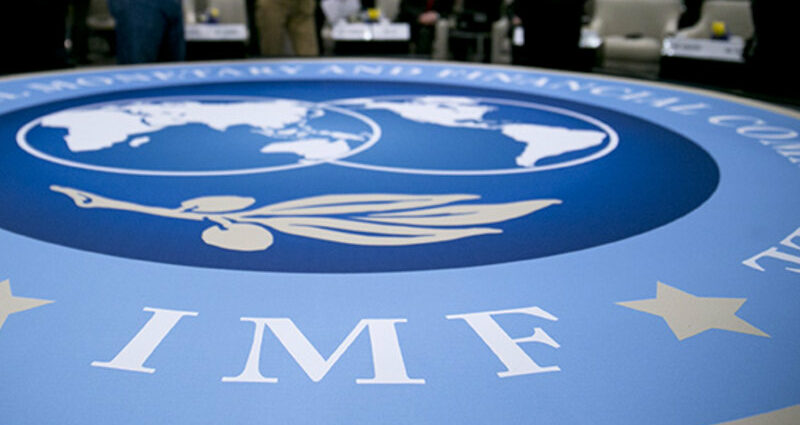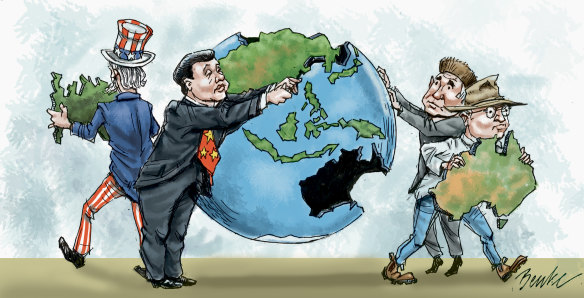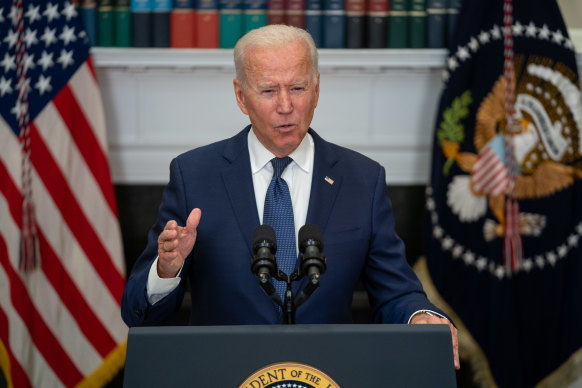In case you’ve been too worried about your mortgage to notice, the era of ever-increasing globalisation has ended. There’s a backlash against greater economic integration and a risk it will start going backwards, causing the global economy to “fragment”.
The process of globalisation involves the free flow of ideas, people, goods, services and financial capital across national borders, leading to economic integration. But, as a new post on the International Monetary Fund’s blog site reminds us, globalisation is not new, and the process has ebbed and flowed over many decades.
Credit:Joe Benke
The post charts the progress of globalisation back more than 150 years. Using openness to international trade – measured as global exports plus imports as a proportion of world gross domestic product – it divides that period into five successive eras.
First came the era of industrialisation between 1870 and 1914, when increasing trade between Europe and the “new world” of North America, Argentina and Australia was driven largely by technological advances in transportation – including steel-hulled, steam-driven ships and refrigeration for shipping meat – which lowered the cost of trade.
The laying of undersea cables to improve communication between countries also helped.
Then came the era of wars and protectionism, beginning with the start of World War I in 1914 and finishing with the end of World War II in 1945.
In between came the Great Depression of the 1930s, which was made much worse than it needed to have been by governments trying to protect their domestic industries by using high import duties (“tariffs”) to keep people buying local.
Dividing the trading world into good guys and bad guys would not suit us, nor our region.
It sounds like a great idea when you do it to other countries. It turns into a stupid idea when they retaliate and do it to you, leaving everyone worse off.
After trade had increased from 30 per cent of world GDP to more than 40 per cent during the era of industrialisation, it had fallen to about 15 per cent by the end of World War II.
Third came the era of tariff reform between 1945 and 1980. Even before the war had ended, the Allies knew they’d have to fix the world economy. They decided to move to a system of fixed exchange rates and establish the IMF and the World Bank. Most importantly, they set up the General Agreement on Tariffs and Trade (now the World Trade Organisation).
The GATT arranged eight successive “rounds” of multilateral trade negotiations, in which the developed countries agreed to big reductions in their barriers to imports. Thanks to all this, trade doubled from 15 per cent of world GDP to 30 per cent.
This led on to the era of “hyperglobalisation” between 1980 and 2008, with the fall of the Berlin Wall in 1989 and collapse of the Soviet Union, bringing the Cold War to an end.
The eighth, biggest and final, “Uruguay” round of the GATT, in 1994, focused on increasing trade between the developed and developing countries, with many poor economies joining the WTO.
China’s economy began growing rapidly after it was opened up in the late 1970s, and in 2001 it was permitted to join the GATT, hugely increasing its trade.
The era also brought a move to floating exchange rates and deregulation of banking systems, leading to much increased investment between rich and poor countries.
As well, big advances in telecommunications, computerisation and the advent of the internet allowed a surge of trade in digital services, including data processing.
Resulting from all this, trade reached a peak of more than 55 per cent of world GDP in 2008, on the eve of the global financial crisis and the Great Recession.
The IMF bloggers label the present period, with figures from 2008 up to 2021, the era of “slowbalisation”. To date, those figures bear this out: trade has reached a plateau of about 55 per cent. More recent figures show world trade has largely bounced back from the initial effects of the pandemic’s global coronacession.
US President Joe Biden has been less combative than his predecessor, but he has not abandoned the trade war.Credit:Bloomberg
It seems the combined effect of the Great Recession and rising protectionist sentiment has stopped trade from continuing to shoot up relative to world GDP, but not caused it to fall back – or not yet.
Less optimistic observers, however, refer to present as the era of “deglobalisation”. They worry that we’re in the early stages of a period of “policy-induced geoeconomic fragmentation”.
It’s not hard to see what’s worrying them. First we had Britain deciding to leave the European Union, then the election of Donald Trump, vowing to “make America great again” by whacking up tariff barriers against the exports of friend and foe alike, and starting a trade war with China.
Now we have the use of trade and other economic sanctions by many countries to punish Russia in its war against Ukraine, which is fragmenting world trade.
US President Joe Biden has toned down his predecessor’s excesses, but not abandoned the trade war. This doesn’t seem to be about protectionism so much as America’s desire not to be overtaken by China as the world’s dominant superpower. In particular, the US wants to stay ahead of the Chinese in advanced digital technology, by denying them access to the latest and best semiconductors.
The risk is that the two could end up dividing the global economy into separate trading blocs, America and its democratic friends versus China and its autocratic friends. This would almost certainly slow the economic growth of both groupings.
And, as economist Dr John Edwards has written, dividing the trading world into good guys and bad guys would not suit us, nor our region. Our exports to China greatly exceed our exports to the US and other close security allies.
And all the East Asian economies – including Japan and South Korea – have China as a major trading partner. For that matter, China and the US are major trading partners of each other.
Fortunately, and despite all the sparring we’ve seen, Edwards and others find no evidence that the US and China have yet started to “decouple”.
Let’s hope economic sense prevails, and it stays that way.
The Business Briefing newsletter delivers major stories, exclusive coverage and expert opinion. Sign up to get it every weekday morning.
Most Viewed in Business
From our partners
Source: Read Full Article
-
Instant coffee and rosé: What a med student on $26,000 spends in a week
-
European Economics Preview: UK Unemployment Data Due
-
U.S. Housing Starts Decrease In November, Building Permits Plunge
-
Eurozone Private Sector Logs Fastest Growth In 9 Months
-
ZIM Integrated Shipping Q4 Results Down, But Top Estimates; Stock Up In Pre-market



